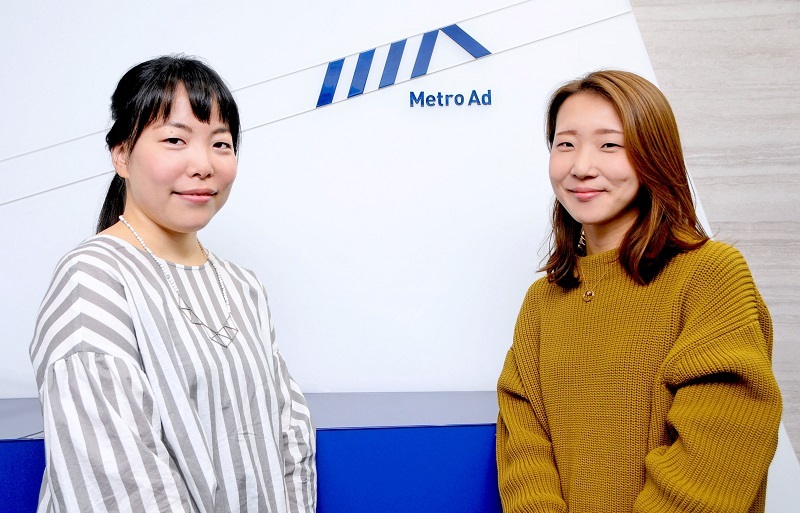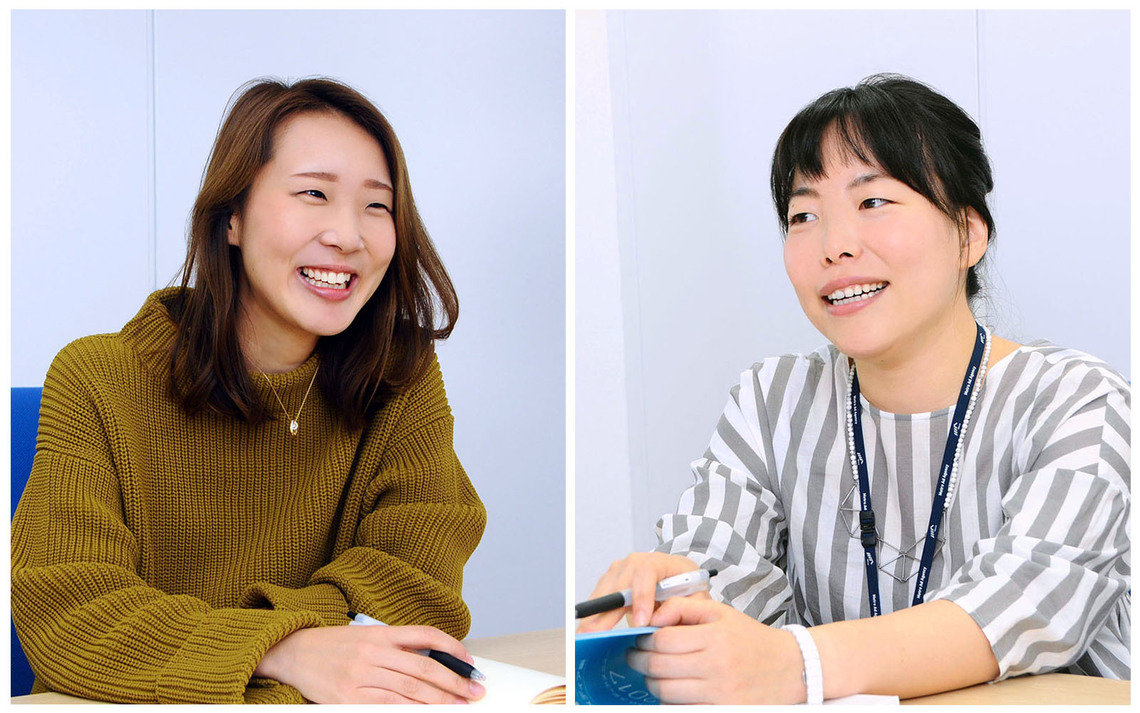The evolution of digital technology is bringing transformative change to OOH (out-of-home and transit advertising). In this series, members of Dentsu Inc.'s Out-of-Home Media Division (OOH Division) will explore the evolution and potential of outdoor and transit advertising, focusing primarily on digital signage.
Part 3 features "Japan's Cutting Edge of Dynamic DOOH" by Kei Hamada of Dentsu Inc. OOH Division and Kyoko Hamada of Metro Ad Agency.

(From left) Kyoko Hamada, Metro Ad Agency; Kei Hamada, Dentsu Inc.
"I installed signage too."
*Hereafter, Hamada from Dentsu Inc. = Hamada (D), Hamada from Metro Ad Agency = Hamada (MA).
Hamada (D): I'm Hamada from Dentsu Inc.
Hamada (Metro Ad): I'm Hamada from Metro Ad (blushing).
Hamada (D): You installed digital signage too, right, Hamada? It makes me happy to think someone in the same industry with the same name went through the same struggles as me (laughs).
Hamada (Metro): I did, I did. It's the same signage system you installed.
Hamada (D): Wasn't the prep work—like power sources and lines—pretty tough?
Hamada (Me): Exactly. In everyday life, power and Wi-Fi are just there, right? But when you install signage, you first have to confirm if "that location" has sufficient power and lines. Plus, for subway stations, since they're "underground," you need permission from the road authority—meaning the national or metropolitan government. It was tough deciding locations while considering all that.
Hamada (Electronics): Yeah, I know what you mean. I totally get how tough it was for you, Hamada (laughs). But Metro already has a lot of signage, right? Why did you decide to do this new digital signage proof-of-concept experiment?
Hamada (Media): First and foremost, it's the growth in DOOH media sales. Until now, Metro's media revenue was centered on paper media like hanging advertisements in cars and stations. But as you can see from the graph, DOOH media sales have grown by 440% over the past five years.

From Tokyo Metro Transportation Media Sales Performance (Source: Metro Ad Agency)
Hamada (Electronics): Seeing this graph made something I vaguely understood suddenly burn into my mind—it was shocking. I had a sense that digital was growing, but seeing that 440% figure on the graph really drives home how incredible it is!
Hamada (Media): Exactly. That's why Metro needs to focus its efforts now on DOOH media, which will be our main revenue driver going forward. Furthermore, I feel the key point is enabling "Dynamic DOOH" ( see previous discussion ), which changes creative based on external data. As an OOH media company, our advantage lies in owning valuable locations. We want to say: it's precisely because it's "right now, at this moment, in this place" that we can deliver what only we can provide.
The "Kinmugi" campaign that resonates with the Japanese spring
Hamada (Denki): That's right. I completely agree. Even with the same Metro signage, the audience's demographics and attitudes differ based on location and time. For instance, when I see signage near my office in Shimbashi, I'm in work mode, thinking, "Oh, this client is running this creative." But on my days off in Omotesando, I'm just a shopping-loving girl looking at the signs. Like, "I came to buy a bag, but now I want this brand's coat!" (laughs).
Hamada (Me): I get it, I get it. In that sense, the Suntory "Kinmugi" campaign that linked its digital signage ads with cherry blossom blooming information was incredibly exciting for us. It was thrilling to finally run a full-scale campaign that dynamically linked with external data, changing daily and even moment by moment depending on the station.
Hamada (E): Cherry blossom blooming really is a huge event, isn't it? For Japanese people, spring arriving feels special, full of hope. By being there for that moment—"Spring, when the cherry blossoms bloom, a new year begins"—Kinmugi makes you feel like drinking it would make you feel even better.
Hamada (Media): I was seeing the signage as part of my job, but during the campaign, I actually got the urge to drink Kinmugi and ended up doing it (laughs). Also, seeing so many patterns displayed thanks to creatives generated dynamically—from the perspective of how transit media has historically worked, this is truly amazing! With the pre-submission style, you couldn't possibly handle hundreds of millions of variations like this.
Boxing Champion Ryota Murata's World Title Fight Ticket-Linked Campaign
Hamada (Electronics): Besides the Suntory campaign, wasn't this year a year of challenges for Metro in relation to dynamic DOOH?
Hamada (Media): That's right. We collaborated on this campaign for boxer Ryota Murata's world title fight.
Hamada (Tel): While real-time ticket updates are standard online, this really highlights the value of OOH's "forced visibility." Even if ticket info is updated online, it only reaches people who actively look for it. But seeing it on a digital sign while passing by can make someone think, "Hey, tickets are still available! Maybe I'll go!" It's precisely the power of OOH's forced visibility – appealing to people as if speaking directly to passersby. Plus, they can buy tickets right away during their commute on the train.
Hamada (M): I think this is a great example of how displaying information that's commonplace online via digital signage can drive attitude change. It really made me realize how something "ordinary" on one medium can feel fresh when presented on a different one.
Hamada (Advertising): It would be great if campaigns like this kept growing, spreading the appeal of dynamic DOOH further and further.
From Dynamic DOOH to Programmatic OOH!
Hamada (Tel): These two examples show the potential of dynamic DOOH, but with the metro's existing delivery system, there's still a lot we can't do yet...
Hamada (Media): That's right. That's our other challenge this year. Speaking of the signage installation mentioned earlier (laughs), we're conducting this kind of proof-of-concept experiment.
■Tokyo Metro Begins Proof-of-Concept Testing for Cloud-Based Digital Signage System at Shinjuku, Akasaka, and Toranomon Stations
Hamada (Electronics): I'd love to add another anecdote about the struggles of installing the signage here (laughs), but setting that aside, is this proof-of-concept driven by a desire to advance dynamic DOOH further?
Hamada (Media): Exactly. Actually, our current signage system can handle dynamic content, but it requires manual setup each time. We face the challenge of needing more flexibility! To solve this, we're exploring systems better suited for dynamic content delivery.
Hamada (Tech): Technology is rapidly transforming the OOH market, isn't it? Honestly, I also think there's room to make things more efficient—not just the content delivery to DOOH, but also managing the vast number of existing ad slots and streamlining workflows like ad submissions.
Hamada (Media): Absolutely!! Furthermore, Japan's OOH lacks audience data comparable to TV ratings. We also want to gather data on "how many people are actually seeing our media, and who they are."
Hamada (Tel): Exactly. Taking it that far would mean evolving into the realm of "Programmatic OOH," where high value-added services and automated transactions advance. Considering that programmatic requires three key elements—a common delivery platform, common metrics, and automated transactions—2017 feels like Metro's first step, a year of challenge. We want to accelerate our shift from dynamic DOOH to programmatic OOH, so that one day, looking back, we can say 2017 was truly the turning point!
Hamada (Metro): Please be sure to actively include our media in your plans (laughs).
Hamada (Tel): Absolutely (laughs). It was great to have this signage talk today, connected through Hamada! Thank you very much!
Hamada (M): Thank you very much indeed!!










